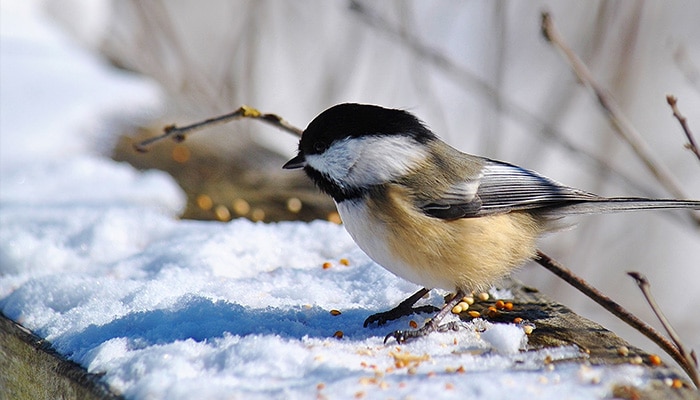While we believe that the books and resources recommended may be of value to you, keep in mind that these are suggestions only and you must do your own due diligence to determine whether the materials are appropriate and suitable for your use. PNC has no sponsorship or endorsement agreement with the authors or publishers of the materials listed.
WINTER

Seed Gathering
Children will explore how birds get food in winter.

Lesson Objective
Children will understand the difficulties that birds living in cold climates have with getting seeds during winter.
ScienceArtMusic
What You'll Need
- Tweezers – 1 per child
- Birdseed – 3 cups
- Ice cube trays – enough so that each child can get 1 ice cube
- Small plastic plates – 1 per child
- Disposable shallow trays – 1 per table
What To Do
Note: This lesson requires preparation the day before the activity.
- The day before the activity, freeze ice cubes containing some bird seed in the water.
- Discuss how birds eat (see Did You Know?).
- Distribute one empty tray to each table. Pour about ½ cup of birdseed on the tray.
- Distribute tweezers, and explain to the children that they will be using tweezers like a bird uses its beak to pick up the seeds (see Did You Know?).
- Discuss the ease or difficulty with this process (see Guiding Student Inquiry).
- Explain that in the cold winter months, seeds get frozen in the earth or in ice and snow, making it more difficult for birds to get enough to eat (see Did You Know?).
- Distribute an ice cube containing bird seed to each child.
- Have the children use the tweezers to try to pick the seeds out of the frozen ice cube.
- Discuss the challenge that the frozen material created for them, and relate this to the challenges for birds living in areas with very cold winters (see Did You Know?).
Resources
Home School Resources
Home educators: use these printable lesson PDFs to teach this lesson to your home schoolers. They're available in English and Spanish.
Content Provided By
Common Core State Standards Initiative – These lessons are aligned with the Common Core State Standards ("CCSS"). The CCSS provide a consistent, clear understanding of the concepts and skills children are expected to learn and guide teachers to provide their students with opportunities to gain these important skills and foundational knowledge [1]. Visit the CCSS


